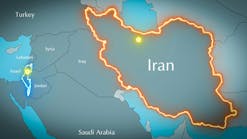Christopher E.H. RossCan you imagine what the oil business would look like if we had frozen our cost structures as they were in the early 1980s?
Arthur D. Little Inc.
Houston
Many more firms would have gone under, far fewer projects would have been attempted, and, ultimately, employment numbers would have declined even more sharply than they have done.
We would have seen a reduction in domestic and international exploration, and North Sea production would have peaked some years ago. The toll on industry stakeholders would have been even more severe than what we have experienced: more trauma among employees, dissatisfaction among owners, and the return of gas lines, angering customers.
Although the cost reductions over the past 15 years were painful, they forced the industry to put resources to work more efficiently, and now we're doing many of the right things in the right ways. Foremost, we've been finding and developing new oil resources from a wide variety of sources at low costs, even while in many areas the quality of the resource base has continued to deteriorate. We've also made great progress in stripping costs out of the entire supply chain, remediating environmental problems, reformulating fuels, and managing risk.
Society wants cheap oil and gas with a low risk of disruption and without any degradation to the environment. For the past decade the industry has substantially been able to provide this. What we have not done, however, is communicate our accomplishments.
For much of the past quarter-century, the oil industry has been at odds with the world. Starting in the early 1970s, environmental demands changed, and the industry was not in a position to redress the problems of the past instantaneously. Nationalism and nationalization became forces that the industry could resist but not arrest. Middle Eastern politics disrupted supply chains and led to uncontrollable price changes, of which the industry was initially the unwitting beneficiary and later the victim. Accidents have happened, with grave environmental consequences. All of these instances have served to further the rift between society and the industry.
However, due in part to its recent successes, the industry now has a unique opportunity to realign itself with the expectations of society. As we at Arthur D. Little discovered in a recent assignment for the National Petroleum Council,1 a number of societal forces are converging to facilitate such a realignment:
- Command and control government is giving way to more goal-oriented regulatory systems.
- A number of environmental organizations are maturing and becoming more open to working with the industry.
- There is a growing distaste for conflict resolution by adversarial confrontation.
Still, above all, it is the industry's accomplishments that most significantly herald this realignment opportunity. If the industry can work on its skills in communicating these accomplishments, and can commit necessary resources to understanding and internalizing the valid concerns of other constituencies, it may be poised for some huge rewards.
Imagine a world in which the industry can engage in constructive conversations with stakeholders instead of litigation; in which access to federal lands is accorded with confidence that the environment will be protected or even enhanced by responsible oil company management; in which fuel specifications are set to meet environmental goals at the lowest cost to everyone; in which alternative dispute resolution displaces the law courts for technical disagreements. Think of the savings to the industry; think of the acceleration in project development.
To daydream for the good old days of high prices would be to waste a good opportunity. The challenge is to organize ourselves for an expanding industry at low prices.
Building blocks
In a low price environment, performance improvement is the name of the game, and over time a number of tools have been created to help meet this challenge (Fig. 1 [21396 bytes]). Because these tools have been developed successively, each building upon the accomplishments of its predecessors, we see them as the "building blocks" of organizational transformation. The latest building block-and one we're putting a lot of thought into at Arthur D. Little-is the "learning organization."
All of these building blocks owe a lot to the original thinking of Peter Drucker, who was driven to understand how to reap benefits from the gigantic leaps taking place in information technology. The subject of information technology will be treated only lightly here, although it underlies all the progress that has been made-from the creation of local profit and loss statements, to 3D seismic workstations, to the advances promised by Petrotechnical Open Software Corp. standards, to directional drilling and automated production systems.
In fact, most of the building blocks for organizational transformation ultimately depend on the prompt and accurate availability of information. Why? Because they transform human and structural systems in ways that process and elevate this information into shared knowledge, leading to better decision-making and therefore to better performance, happy shareholders, satisfied customers, and motivated employees.
The first building block-decentralization-was used to help companies break down their traditional functional "stove-pipe" organizations into businesses whose performance could be measured and whose managers could be held accountable for profitability, growth, and return on capital employed.
Next came techniques of total quality management (TQM), derived from Deming's work on statistical process control, which led to various team-based problem-solving approaches generally applied within a work group. TQM pioneered the development of organic performance improvement.
Then we moved on to business process redesign (BPR), which used techniques similar to TQM but sought improvement opportunities across organizational boundaries.
Our next methodology, the high performance business (HPB), linked BPR to strategic thinking and posited organization structure, resources, and business processes in a holistic framework.
"Virtualization" then extended the HPB concept to the full supply chain, delegating more noncore activities in the chain to third parties through outsourcing. Virtualization helped companies rethink what they should be doing themselves and what they could get others to do for them more efficiently.
Most recently, we are seeing-and developing ourselves-increasing interest in the learning organization as a way of consciously embedding processes for continual performance improvement within a company.
While each new approach to organizational transformation has been introduced with a certain degree of fanfare, the approaches should not be seen as mere fads. Each has made a lasting contribution to performance improvement. Each has built on the successes of the preceding approach. Each remains a valid and useful way of contributing to the transformation and improvement of a company. Each has produced proven benefits.
Side effects
Unfortunately, each building block has also produced organizational side effects (Fig. 2 [27561 bytes]).
Decentralization did indeed bring accountability and profit improvement, but it also created "silos" and barriers between businesses as well as conflict between the businesses and functions designated as allocated overhead.
TQM allowed incremental performance improvement and introduced the concept of teams looking at business problems from a fact-based mindset but in many cases turned out to be very time-consuming for relatively small gains.
BPR introduced the notion of process thinking and definitely resulted in step function improvements but all too often has been used as an excuse for manpower reduction, leaving the workforce demoralized and the organization bereft of strategic direction.
HPB provided a framework for aligning BPR with strategic direction, but because companies often sensed that the change was being done to rather than by the organization, improvements were often one-time events.
Virtualization took the gains further by forcing companies to focus on core capabilities, reexamine operator-supplier relationships, and simplify the entire supply chain. However, many operators are now concerned that they may be losing some key capabilities that in fact define what they are as oil companies.
Despite their side effects, these approaches for organizational transformation have all played a positive role in increasing the efficiency of businesses both within and outside the petroleum industry.
Applying the approaches
As part of our internal Continuous Improvement Task Force, which started working the TQM issue in 1987, I have been intimately involved in developing and applying our ideas in these earlier approaches in recent years. I view the approaches as parts of a coherent body of knowledge on how to institutionalize performance improvement in companies.
I used the HPB as the conceptual model for restructuring YPF Argentina, which became one of the largest and most successful privatizations of all time (Fig. 3 [20742 bytes]). It was successful at least in part because there was a persuasive story on the alignment of strategy, organization, business processes, and resources.
However, I have to admit that it was a top-down initiative: It is not possible to tackle change of that magnitude by a consensus process. On the other hand, in order to realize continuous performance improvement gains, it is necessary to make the transformation process organic within the organization.
Working with YPF, as well as with a number of our other clients, we became aware how much management time was wasted on activities that did not seem to add value. We also saw that there was a great deal of rework between oil companies and their contractors.
As a result, we developed the Virtual Oil CompanyTM model as a provocative new way of thinking about the business (Fig. 4 [22231 bytes]). A number of people in the industry have told me that it is a useful mental model that goads people into asking the question, "Do we really need to do that?"
Now we at Arthur D. Little are grappling with a new paradigm, "the learning organization," based on well-defined, intentional processes for fostering ongoing, harmonious, and productive change. To that end, we have recently acquired Innovation Associates, the company founded by Peter Senge (author of The Fifth Discipline) and Charlie Kiefer, and are integrating their thinking into our management consulting work. We are also working with Prof. David Garvin of the Harvard Business School to further develop our ideas on how to make the learning organization a reality.
Attributes
The learning that takes place in a truly learning organization is deliberate, highly connected to company strategy, and anticipatory of challenges and threats to the organization. We are finding that four key attributes foster the learning organization: strong, passionate leadership; a shared vision; a high degree of accountability at every level of the organization; but also an ability to transcend the myopia of profit centers through a larger learning culture.
We asked Charlie Kiefer to write about leadership in our quarterly management journal Prism. More than simply a set of skills, be it inherent or acquired, Kiefer sees leadership as a state of being.
"Leadership is what the rest of us call it when we see someone doing something they love and we want to help...," he observes. "Leaders stand for something. They have created or found something in life that truly matters to them-something that they naturally take a stand for." Leaders have a vision, but more important they are able to share the vision so that it becomes a collective vision. True leaders are also never satisfied with the status quo and drive their organizations towards innovation.
In most cases, the leader's initial vision is not fully formed. It comprises a concept of what the company might become, a set of values or principles, and a business theory.
There is plenty of scope to engage the rest of the organization in rounding out the vision. By engaging others, it becomes shared and acts as a compass that provides direction to the whole organization. As important, the direction provided by the shared vision eliminates the need for many of the controls, permission-getting, and recriminations that take up so much time and expense in many companies.
As in any high performance business, accountability remains vitally important. Indeed, stretch performance targets are a prerequisite and provide the motivation for improvement. There is nothing "soft" about the learning organization. The accountability works both ways: Managers can hold subordinates responsible for meeting their performance goals but also need to be held responsible by their subordinates for providing the necessary support.
Further, strong accountability can ultimately become dysfunctional unless it is coupled with a learning culture. Such a culture, if reinforced by leadership from the top, will elevate people's ability to seek improvement opportunities across organizational boundaries.
How do organizations learn (Fig. 6 [22945 bytes])? First they develop the ability to learn to act. This is not unlike the Deming virtuous circle. They create a shared awareness of an issue that needs resolution; they develop a common understanding of the nature of the issue and how best to resolve it; they take aligned action; they jointly review the results. Then they start again on another issue.
However, true learning organizations also take the time to learn how to learn. This requires collective reflection on how learning is being done, and how it might be done better. I know this sounds abstract and difficult. It is. But a true learning culture demands this kind of reflection so that the learning tasks do not become rote.
Mindset vs. methodology
Ultimately, the learning organization is a mindset more than a methodology.
TQM brought continuous improvement and fact-based analysis into everyday management and helped remove the old adage "we pay you to work, not to think." Its contribution was not only in the very useful tools that were developed to aid the analysis but in the changed world-view that managers developed as a result of using them and encouraging others to use them.
In the same way, the learning organization aims to change managers' world-views but on a different and greater scale than TQM by using a number of valuable tools (Fig. 7 [14311 bytes]).
Training obviously has a role to play: training in use of the tools of learning; training in absorbing and reactualizing the company's vision; training in team dynamics. We have been working with the Venezuelan national oil company, Petroleos de Venezuela SA, to rethink the strategy and organization of its training institute, CIED, as it gears up to meet the competitive challenges that will follow the opening up of Venezuelan exploration prospects to international companies. This has reaffirmed our conviction that focused training is essential for change.
Organizational learning can also be instilled through the deliberate use of top-down, bottom-up, and horizontal processes for visioning, strategy development, planning, problem-solving, and project development.
The effective use of teams crossing organizational boundaries is also a vital contributor to organizational learning and is part of creative issue resolution. The other part is recognition of the complexity of issues. Again, training can help in this. Our new partners, Innovation Associates, have done seminal work in how to make teams function well, even in the most individualistic companies.
Alliances with third party companies can be fruitful, as new perspectives and approaches are applied to a company's business. We are working with a number of companies active in the Gulf of Mexico and North Sea, assessing how the division of responsibilities between operators and service companies might unfold, and how the services may be packaged for best results for the industry as a whole.
Information technology is a powerful enabler. Bulletin boards, data bases, and mathematical models all have roles to play.
Finally, performance measurement and reward systems must reinforce the goals of the learning organization. They should be used to align the various stakeholders in the company: employees with owners, customers and suppliers, and managers with subordinates. In this regard, we strongly support 360° performance reviews as a mechanism to help managers learn how to be more effective leaders, and to assure that accountability is truly a two-way street.
The human side of the equation is ultimately the determinant of success, and unless managers learn to listen as well as to talk nothing will change.
It is the alignment of all these tools into a holistic program that will enable the learning organization to emerge. Pieces exist in parts of many companies, but few can claim to have an integrated program in place to assure that all employees are aligned around continuous substantial performance improvement that transcends organizational boundaries.
Shared responsibility
Ultimately, it is the oil and gas industry's shared responsibility to continue to find ways to do things better, faster, cheaper, and safer in order to satisfy the expectations of society for low-cost energy delivered and consumed with as little damage to the environment as possible. The consequence of backing away from that challenge is to seal the fate of the oil industry as an aging industry, out of touch with its stakeholders, and increasingly marginalized by society.
The wide array of organizational transformation and performance improvement approaches will continue to contribute mightily to the objective of meeting our shared responsibility, especially when used within the context of an integrated, holistic learning organization framework.
If companies can continue to evolve internally towards becoming true learning organizations, they will be much better equipped to reposition themselves externally as integral to the interests of society.
Reference
1. "Future Issues: A View of U.S. Oil and Natural Gas to 2010," report to the National Petroleum Council, Arthur D. Little Inc., August 1995.The Author
Christopher E.H. Ross is a vice-president and managing director in the international energy management consulting business of Arthur D. Little Inc. He specializes in strategy and organization issues for oil and gas companies.
Copyright 1996 Oil & Gas Journal. All Rights Reserved.



